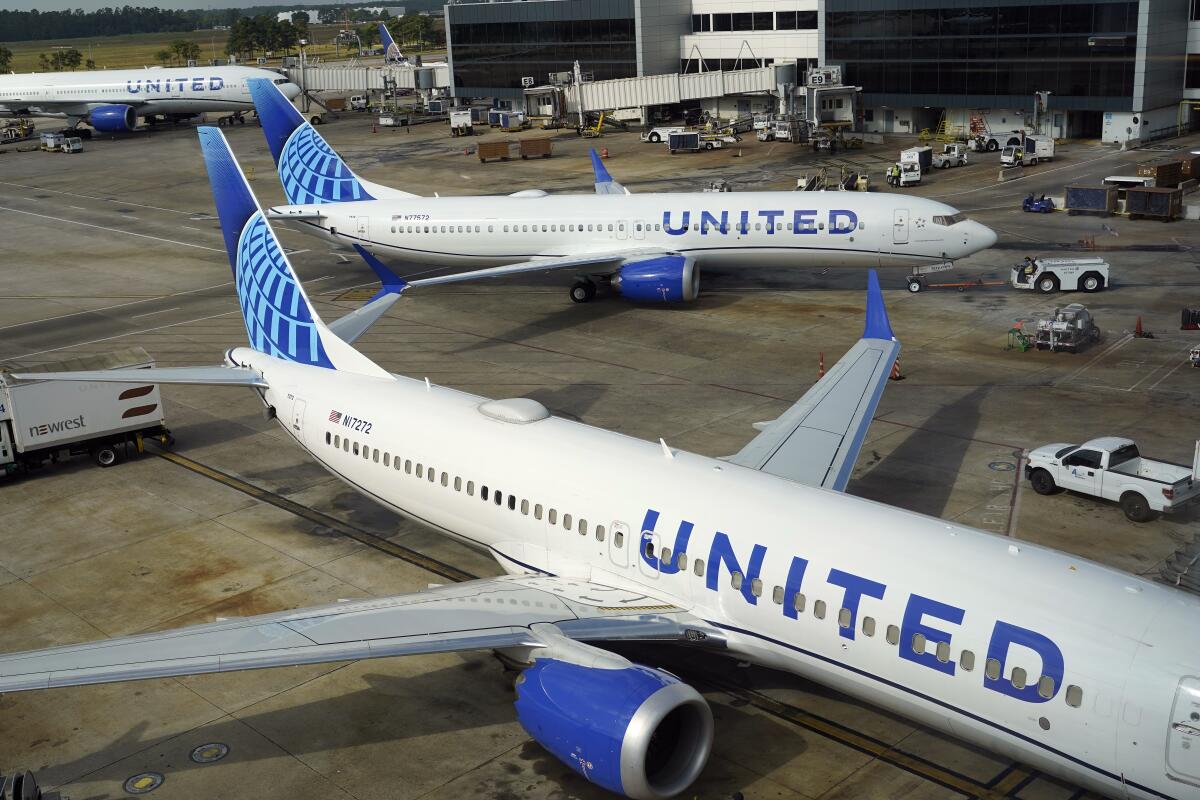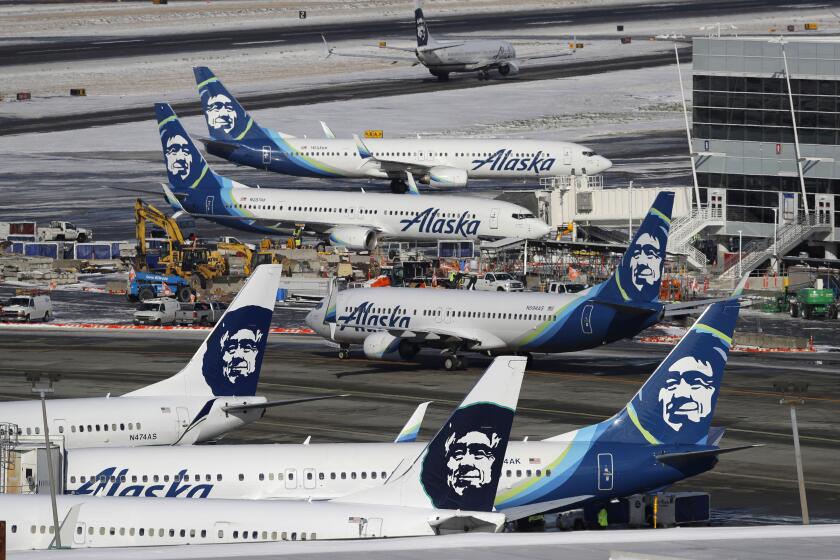United, Alaska find loose hardware on jets amid probe into Boeing 737 Max 9 blowout

Both Alaska and United airlines have found problems with door plugs on their Boeing 737 Max 9 jets after the “explosive” blowout late last week of the same piece of fuselage on an Alaska flight. On Monday, Alaska reported that investigators found “loose hardware,” and United also reported loose bolts.
Hardware failure could contribute to the door plug becoming dislodged, despite the presence of 12 “stops” in the door plug design, according to the National Transportation Safety Board.
The agency is in the preliminary stages of its investigation into the Friday night incident on Alaska Airlines Flight 1282, which was traveling from Portland International Airport to Ontario. The NTSB found the door shifted upward, and “all 12 stops became disengaged, allowing it to blow out of the fuselage,” said Clint Crookshanks, an NTSB investigator, at a news conference Monday night.
Both United and Alaska have grounded their fleets of the commercial airplanes and canceled hundreds of flights in the aftermath of the incident.
The aircraft had reached about 16,000 feet elevation when the cabin underwent “explosive decompression,” according to Jennifer Homendy, chair of the National Transportation Safety Board, and the door plug burst off the side of the plane.
Among revelations at a Sunday night news conference, the NTSB chief said the door plug the agency had been searching for had been found by a Portland, Ore., teacher in his backyard.
The teacher, referred to only by his first name, contacted the NTSB via email and sent two photos of the piece of fuselage, which was described as a 63-pound piece of the plane that is yellow-green in color on one side and white on the other. Two cellphones that plummeted from the aircraft also were found in the vicinity.
“Bob was a star with all his students today,” Homendy said at Monday’s news conference.
Cockpit audio from the Alaska Airlines flight that lost a chunk of fuselage was overwritten, the NTSB says. But an Oregon teacher found the door plug.
A focus of the investigation on Monday was a warning light on Flight 1282 that had illuminated at least three times in the last month — including in the two days preceding Friday night’s blowout — possibly indicating a pressurization problem on the aircraft.
Alaska Airlines had restricted the jet from transcontinental routes so that the plane could return to an airport during an emergency, Homendy said.
Because the pressurization light had gone off several times, additional maintenance was ordered on the plane, but it had not yet been performed before Friday’s flight.
Homendy said on Monday night, however, that the light was part of a larger system maintaining safe cabin pressure and it had “operated as designed.” She said there were “no indications whatsoever that this correlated in any way” with the plug door blowout.
This is not the first time loose bolts have been discovered on Boeing 737 Max 9 jets; in late December, Boeing issued a warning to all airlines with 737 Max planes to inspect the aircraft for possible loose bolts in the rudder-control system after an airline reported a missing nut while conducting routine maintenance.
Boeing President and Chief Executive David Calhoun sent a companywide email Sunday canceling the organization’s annual leadership retreat to instead host a “safety webcast” with members of the executive leadership team.
“While we’ve made progress in strengthening our safety management and quality control systems and processes in the last few years, situations like this are a reminder that we must remain focused on continuing to improve every day,” the email read.
Federal officials on Sunday night also pointed out a major obstacle to the Alaska Airlines investigation: The cockpit voice recorder, or black box, from the Friday night flight was erased.
Homendy said that after the aircraft returned to Portland International Airport, no one pulled the circuit breaker on the cockpit voice recorder or otherwise preserved the audio, which holds only its most recent two hours.
“The cockpit voice recorder was completely overwritten. There was nothing on the cockpit voice recorder,” Homendy said.
Homendy was visibly exasperated by the loss of the black box recording. She noted that it was a “very chaotic event” when the plane landed and officials set up an emergency operations center.
“The maintenance team went out to get [the cockpit voice recorder], but it was right at about the two-hour mark,” she said, later adding: “We have nothing.”
She pointed to about 10 other recent incidents when voice recorders were overwritten, including a 2017 near-catastrophe at San Francisco’s airport when an Air Canada plane almost landed on a taxiway and would have collided with other jets carrying about 1,000 passengers. She called on the Federal Aviation Administration and Congress to implement a rule that would require new and existing planes to store audio for 25 hours, which aligns with European audio-retention practices.
“If that communication is not recorded, that is unfortunately a loss for us and a loss for FAA and a loss for safety,” she said, “because that information is key.”
Alaska Airlines did not respond to questions about the cockpit voice recorder or whether the airline would voluntarily install recorders that store audio for 25 hours.
Asked to offer any theories about what caused the plane’s door plug to blow off, Homendy demurred.
“Right now we are in a fact-finding phase of the investigation,” the NTSB chief said, adding that staff were poring over the Boeing 737 Max 9 aircraft for clues and planned to send key components to a lab to analyze any fractures, paint marks and shearing that could help explain what happened.
Surveying the aircraft, officials found damage in more than a dozen rows inside but had not identified any structural damage to the aircraft. The plug that blew off the plane was covering an unused emergency exit opening near Rows 25 and 26, and was essentially bolted to the aircraft structure. The plug was covered in paneling and included a window so that, from inside the cabin, it would appear indistinguishable from other rows.
Homendy on Sunday praised the crew for their response during the emergency.
The NTSB on Monday interviewed two of the four flight attendants who were on board, according to Hemondy. They, like other crew members, said they faced significant challenges communicating with colleagues after the fuselage blew out — and were not even sure what had occurred.
Homendy said the flight attendants had attended peer-to-peer counseling since the incident.
“This was a really significant event, with zero information at the time,” Homendy said. “There is a lot of trauma that they working through. It’s going to be a long process. It was terrifying.”
Passengers and crew reported hearing “a bang,” she said, when the “explosive decompression” occurred after the plug was expelled from the fuselage.
“It was described as chaos, very loud,” she said. The cockpit door flew open, and the captain partly lost and first officer completely lost their respective headsets.
“Flight attendants reported that it was difficult to get information from the flight deck, and the flight deck was also having difficulty communicating,” Homendy said.
The plane had six crew members and 171 passengers, including three babies and four unaccompanied minors.
“The flight attendants were very focused on what was going on with those children. Were they safe? Were they secure?”
In a stroke of luck, two seats were empty directly next to the spot where the hole opened in the plane.
Seats in that area showed signs of damage, including sheared oxygen masks, lost headrests and torquing.
“There was a lot of damage to the interior paneling and trim,” she said. “It must have been a terrifying event to experience.”
Although U.S. airlines have grounded their planes, European airlines such as Icelandair are continuing to fly Boeing 737 Max 9s; the planes do not have the same configuration as that covered by the FAA order, according to the European Union Aviation Safety Agency.
Both Boeing 737 Max 9 and Max 8 were previously grounded from March 2019 until November 2020 after two Boeing 737 Max planes crashed in 2018 and 2019, killing 346 people aboard.
The Max’s design included a larger engine, the placement of which could cause the craft to pitch up. Software was created to counteract that, but investigators determined that a faulty sensor triggered the software system to nosedive under certain conditions.
More to Read
Sign up for Essential California
The most important California stories and recommendations in your inbox every morning.
You may occasionally receive promotional content from the Los Angeles Times.













